Time Team - November 2008
5-Nov-20084BR looks back over the past 125 years to see how advertisers have tried to flog us their goods - from busty Besson women to Slack & Cox beer...
There is no better indicator of our acceptance as being a ravenous consumer society, than the way in which we accept advertising as part of our everyday lives.
Turn on the television, log onto the internet, listen to the radio, open a newspaper, browse a magazine, support your local football team, look out from the window of your car – even open your wardrobe to see what you want to wear today.
It has become the manna from which we nourish our misplaced conceptions of want instead of need. And advertisers know it.
Varied forms
Advertising in all its many and varied forms is everywhere. We have accepted its intrusion into our everyday lives without a second thought. We have become walking billboards for logos and icons, labels and motifs, with little understanding of what they are, or even represent.
There was of course a much more innocent time – pre television perhaps. However, there has never been a time when some bright Alec thought that spending a few pounds on advertising their wares wasn’t a good idea to make a few quid back into the bargain.
Mantra
The entrepreneur’s mantra of ‘speculate to accumulate’ has always ringed true – even in the brass band world.
Looking at publications and bras band programmes over the past 100 years or more tells us that – from the reserved probity of Edwardian adverts in the programmes for the National Brass Band Championships at the turn of the century, to the use of subliminal association that now passes for advertising on the internet.
Performing monkeys
As a social phenomenon it tells us more than anything else about how we view ourselves and how other people view us – from pre war adverts for uniforms and pianos to half naked girls provocatively posing with big brass instruments in the mid 1970s.
Everyone and everything has been fair game for promotion over the years – from the amazing attractions of Belle Vue and Crystal Palace, such as Maud Rochez and her ‘Amazing Performing Monkeys’, to the weekly delights of the lovely lady from Gabriel’s Horn House who used to send the pulse rates of teenager brass players through the roof in her weekly pose on a chaise lounge in a bid to flog you a Besson trombone in British Bandsman in the 1980s.
Advertisers in the 1905 Crystal Palace programme must have thought bandsmen really were a temperance lot, with just the one small advert for ‘Buchanan’s Scotch Whiskey’ – ‘House of Commons Blend’ set againt one for Epps’s Cocoa – ‘Most Nutrious, Grateful and Comforting’
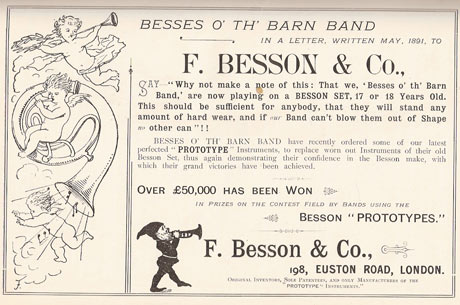
Besson use Besses o' th' Barn to sell their instruments in 1892 (complete with cornet playing elf!)
Meanwhile, years before in 1892, Besson had already cottoned onto the fact that ‘stars’ sell, with their advert promoting the virtues of their ‘prototype’ instruments, using perhaps the greatest band of its day, Besses o’ th’ Barn to flog its goods.
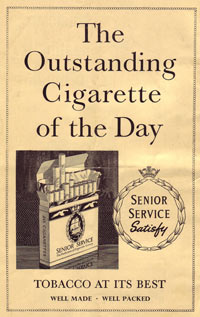 After the First World War, and with huge crowds of bandsmen flocking to Crystal Palace, the instrument makers, music publishers and even the record companies had cottoned onto the fact that there was a ready and willing market to be exploited.
After the First World War, and with huge crowds of bandsmen flocking to Crystal Palace, the instrument makers, music publishers and even the record companies had cottoned onto the fact that there was a ready and willing market to be exploited.
Cuddle Closer
In 1922 Boosey & Hawkes provided a free cinema show so that potential customers could see just how their instruments were made (and used by leading bands such as Besses, Black Dyke and Fodens they chirped), Lawrence Wright’s popular Band Journal advertised their latest release, the foxtrot ‘Cuddle Closer’, and Zonaphone Records advertised the latest release from the St Hilda Colliery Band.
At the last contest before the Second World War, Peter Maurice Music took out an advert to get you to buy the latest release’ Saddle your Blues to a Wild Mustang’, R. Smith & Co championed pieces such as ‘The Moorland Fiddlers’ and the LNER Railway company advertised half fares to London from such exotic outposts of Albion as Jarrow (35 shillings and 8 pence) and Barnsley (22/10).
Brylcream
The dourness of the 1950s still saw adverts for Uniquip Uniforms, although celebrity endorseeship saw Besson use a brylcreamed Ken Smith and dapper Willie Lang as the faces of their ‘New Standard 181 Cornet’ adverts – both dressed in tuxedos.
Advertisers also saw that brass bands were ripe material for humour too – Murraymints advertised on the back of the 1956 National programme with the byline ‘The sweets on which all bandsmen simply dote…’
Fags & Booze
Alcohol and tobacco though were never far away and by this time the likes of ‘Old Charlie Rum’ and Senior Service cigarettes regularly told us all just how good they were for a bandsman’s constitution.
By the swinging 1960s newspapers such as ‘The People’ found a willing readership rather liked pretty girls to brighten up their day, and that liberal attitude soon found its way into brass advertising too.
Boosey opted for a Twiggy look-alike to help promote their instruments in 1968, and a slightly more Reubensian lady to grab your attention for those with larger things on their mind.
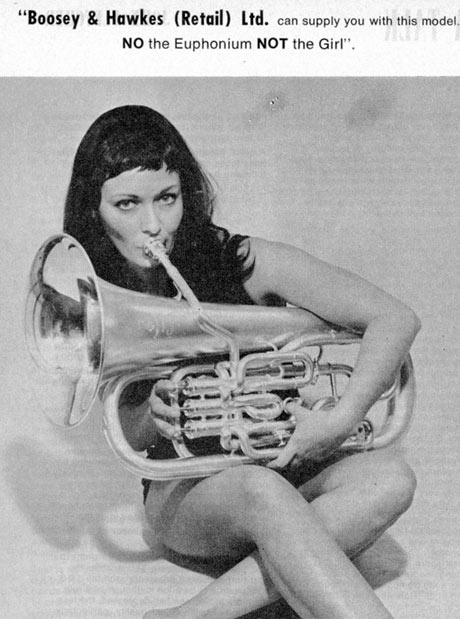
Fancy getting your lips on that? Besson opt for girl power to seel in the late 1960s
Meanwhile the British Open, which strangely had a very conservative attitude to advertising in its programmes before and after the Second World War, relented somewhat in the 1960s.
That was seen to such an extent that by 1966, adverts for brass band records and Besson instruments were found next to ones for Jubilee Stout and the unfortunately named (for bandsmen surely) Slack & Cox beer – talk about an aid to performance!
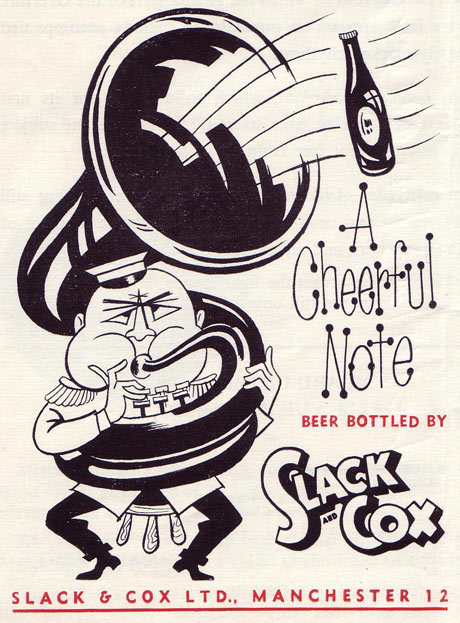
Misplaced humour? Slack & Cox beer - for the Sousaphone player with three udders by the looks of it...
The 1970s meanwhile saw the first cold wind from the Far East and adverts starting to appear for Yamaha Musical Instruments from Bill Lewington Ltd - ‘A 78 year tradition combining unsurpassed sound technology’ they claimed – and people started to buy them too.
By 1977 even the Americans from Olds and King trombones (complete with gormless looking player) started getting in on the act. British instrument makers were under attack.
100 year old echoes
Boosey responded by launching new lines and colour adverts in the National programmes for their ‘Sovereign range’ of instruments – the cornets of which were endorsed by Black Dyke Mills Band – echoes of Besses almost 100 years before.
The 1980s and the rampant ‘credit’ era saw much more brazen approaches to getting you to part with your money. Lots of small outlets were starting to feel the pinch though, and once popular names such as Eddie Moors Music, Professional Percussion, H. Booth & Son, Brass Retrievers, battled against the big boys with big advertising budgets. No guessing who survived.
The lady from Gabriel's Horn House though was a cracker and must have single handedly got more orders than any flash salesman could muster.
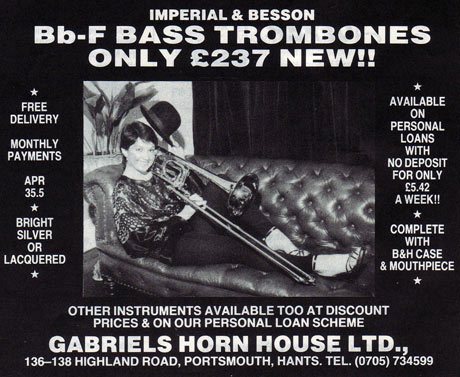
Setting the pulses racing - a pretty face does no harm to sales...
The boom in credit in the 1990’s and the huge boost to bands that came with the National Lottery funds saw the last great ‘Gold Rush’ for the instrument makers – as advertising led to huge sales through easy lottery pickings.
Besson even had their own dedicated ‘hotline’ so that bands could call directly to purchase instruments as soon as their lottery money was in their pockets.
It wasn’t to last however and when the lottery river dried up, even the likes of Besson found it hard to attract new customers.
New advertising
Now advertising is slicker, more efficient, and more responsive to customer needs. In the past few years business has changed the way in which it spends its advertising budgets from the printed press to the internet – from static adverts to proactive images, linked by the click of a mouse to the very heart of their own business.
Who needs expensive shops and sales staff the accountants say, when you can sell an instrument on the internet by credit card and send it out within 24 hours from a warehouse in India.
Times have changed, advertising has changed, the way in which we consume has changed.
All that hasn’t, is the advertisers ability to get us to buy something that perhaps we don’t particularly need, but, absolutely want…
Iwan Fox















